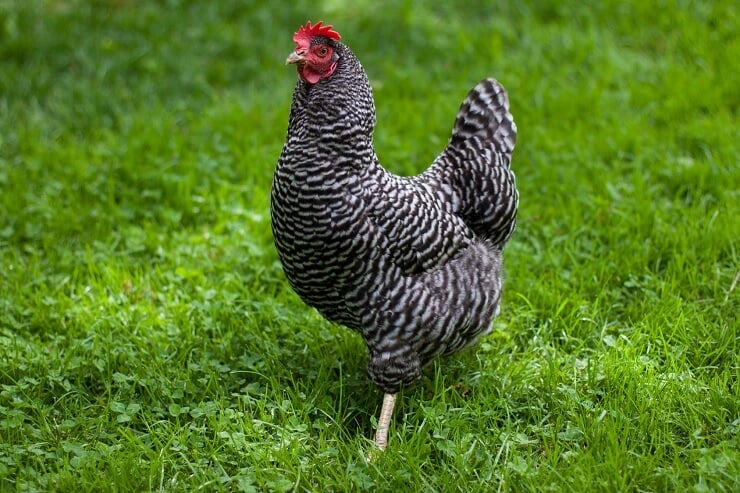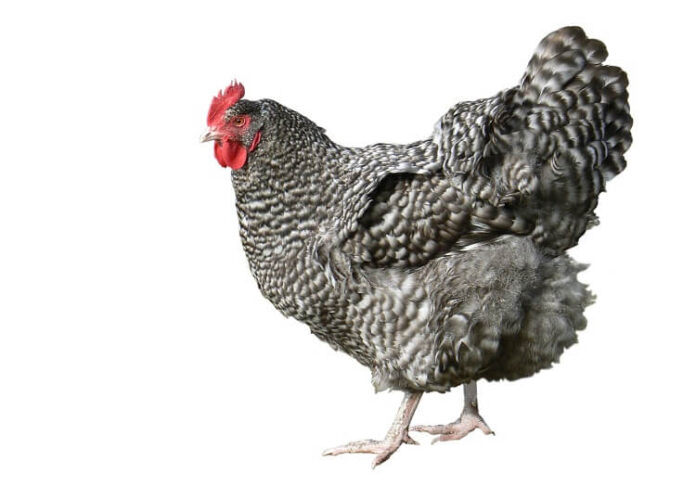Last Updated on July 2, 2021 by Fumipets
The Plymouth Rock is undoubtedly one of America’s oldest chicken breed. Before the end of World War II, the hen was seen from coast to coast, and it became the country’s primary supplier of chicken meat and eggs.
The only hen that could compete with it as a dual purpose hen was the Rhode Island Red, which excelled in both meat and egg production.
Almost everyone used to keep them, and the government encouraged it since the military needed food to battle over the seas and at the home front.
Thousands of people welcomed and embraced them at this period, but the chicken business became more automated after they concluded the war. The Plymouth Rock, like so many other breeds, was abandoned because it wasn’t prolific enough.
We’ll go over all you need to know about the Plymouth Rock chicken in this post, including the many types, egg-laying abilities, how to care for them, and more…

Overview
| Plymouth Rock Chicken | |
|---|---|
| Beginner Friendly: | Yes. |
| Lifespan: | 8+ years. |
| Weight: | Hens (7lb) Roosters (9.5lb). |
| Color: | Black, white. |
| Egg Production: | 4-5 per week. |
| Egg Color: | Light brown. |
| Known For Broodiness: | No. |
| Good With Children: | Yes. |
| Cost of Chicken: | $3-5 per chick. |
Background and History of the Plymouth Rock
The Plymouth Rock was first seen in Massachusetts in 1849. No one knows what happened to the original birds, who seem to have vanished over the last 20 years or so.
Around 1869, a certain Mr. Upham of Worcester, Massachusetts, started breeding barred males with Java hens, and the trail heats up again.
It has been suggested that he was aiming to breed for banded plumage and clean legs.
These birds are now regarded to be the progenitors of today’s Plymouth Rock.
You will recall that there was considerable misunderstanding between rose comb and single comb birds, both of which were referred to be Dominiques at the time.
The New York Poultry Society was adamant about establishing the Dominique as a rose combed breed. All other single-combed birds became Plymouth Rocks by default after 1870.
Appearance
Most people would respond “black and white bars” when asked to describe the plumage of a Plymouth Rock hen, which is right up to a point.
The separating of the sexes is a little different. Males have equal amounts of black and white barring, and each feather has a dark tip.
Females have somewhat broader black bars than males, which might give them a somewhat deeper greyish tone than males.
As we’ll see, the Plymouth Rock family includes numerous different kinds.
The oldest and most well-known Plymouth Rock is the Barred Plymouth Rock.
In fact, the barred Plymouth Rock member of the family is undoubtedly iconic in American society, therefore we’ll talk about it in this post.
Its body is massive and strong, with a big breast and a long, wide back.
The feathers, particularly on the belly, are full, loose, and extremely soft.
Unlike the Dominique, which is considerably fuzzier and drifts towards grey, the barring pattern should be strongly defined black and white.
Their skin and legs are yellow, and they have four toes on each foot. Their ear lobes, comb, and wattles, as well as their face, should all be read.
The eyes are a reddish bay colour, and the beak is horn coloured. Finally, they should have a single comb with five points.
A standard-sized hen would weigh about 8 pounds, while roosters may weigh up to 10 pounds.
There is a bantam variant, with females weighing 2.5 pounds and males at 3.0 pounds.

Breed Standard
In 1874, the American Poultry Association accepted the Barred Plymouth Rock breed. There are now seven recognised variants. In the United States, the following Plymouth Rock types are recognised; barred, blue, b uff
Colombian, Patridge, Silver Penciled and white.
Only five types are recognised by the Poultry Club of Great Britain (Barred, Black, Buff, Colombian, and White), although the European Association of Poultry acknowledges ten.
The APA labels the breed as American, whereas the PCGB labels it as soft feathered and hefty.
Temperament and Egg Laying
Plymouth Rocks are well-known for their big brown eggs. They lay approximately 200 eggs each year on an average, which equals around 4 eggs each week.
For the first couple of years, they lay well, but around the third year, a steady drop in output begins. Hens, on the other hand, have been known to lay for up to ten years!
They aren’t renowned for broodiness, but it may be deliberately cultivated in this breed, since the hens are typically excellent sitters and mothers.
The chicks quickly feather out and develop, and they may be considered broilers at 8-12 weeks of age if desired.
Barred Rocks are placid birds in terms of attitude. They don’t have nasty attitudes or pick on their flock members, and they seem to get along with everyone.
Even the roosters are characterised as nice, quiet, and gentle by their owners.
Plymouth Rocks are naturally inquisitive, and they like exploring their surroundings and following you about to see what you’re doing to and if there are any treats to be found.
Rocks love to roam free and hunt for yummy treats in the yard, but they may accept confinement if given enough room.
This is a really trustworthy hen after you’ve built your bond with her, and she’s fantastic with the family and children.
Health Issues
Plymouth Rocks are a strong and robust breed. Except for the regular assortment of parasites, they aren’t affected by any specific diseases.
Because roosters have huge combs and wattles, they may need additional care in the event of extreme cold.
Because they have a rich genetic pool, they are normally robust, long-lived birds that may live for 10 to 12 years if properly cared for.
Extremely long-lived birds have been known to live up to 20 years!

Coop Setup
Plymouth Rocks are huge hens that need a total of 40 square feet of coop space.
Although they are not naturally violent, living in close quarters may develop to antisocial behaviour such as feather plucking.
The regular 8-10 inch roost will enough for roosting area. If you can, give them a little more space to spread out during the warmer months, but in the winter, you’ll find them all huddled up together to remain warm.
When it comes to nesting boxes, a 12 by 12 inch box will suffice.
It will enough to have one nesting box for every three or four hens, but they will always have a favourite box that everyone wants to use!
Is The Plymouth Rock Chicken Right For You?
This might be the bird for you if you’re seeking for a breed that’s good for a family. Children and adults alike are known to be nice to Barred Rocks. They adore being cuddled and fussed over, and many of them end up as lap chickens!
They don’t fly well, so you don’t need a high fence surrounding their cage to keep them in; they’re not likely to disturb the neighbours’ yard unless they can walk there.
Still speaking of neighbours, the Barred Rock is known as a quiet yet chatty chicken.
Although the Barred Rock has the typical chicken language, including the egg song, it prefers to ‘whisper’ than than ‘shout’ across the yard. The neighbours should be happy as a result of this.
They are a fantastic option for first-time chicken owners since they are laid-back and simple to care for.
Rocks are forgiving of terrible management techniques, but they shouldn’t have to be. They can almost raise themselves if properly handled and cared for!
Their laid-back demeanour also makes them a wonderful fit for 4H projects and exhibitions, where they frequently perform well.

Conclusion
Even if its beginnings are a little hazy, the Barred Rock has a long and illustrious history.
The popularity of the Barred Rock waned after World War II. The breed was included to the American Livestock Breed Conservancy’s list of endangered livestock breeds. It is still classified as recovering on the ALBC website.
The increase is most likely due to a revived interest in backyard hens, particularly dual-purpose varieties that can adapt to practically any situation.
Barred Rock chickens now may be classified into three distinct groups:
Exhibition: These birds are all about plumage and conformation. Productivity will often suffer as a result.
Industrial Production: High-volume producers developed specifically for the poultry business, not ideal for 4H.
Old Dual Purpose chickens: These are the chickens Grandma owned. Eggs and meat may be counted on. Long-lived and friendly, with just little maintenance requirements.
They’ll work in almost every situation you can think of.
They do well as backyard birds; they accept confinement or free-range living, need no particular care, and are talkative and personable. The egg production is excellent, and they dress out beautifully to a decent weight as meat birds. What could you possibly want of your chickens?


















